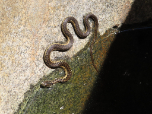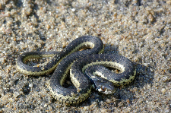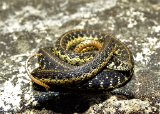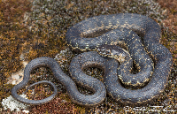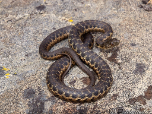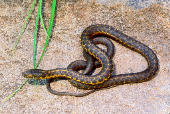Sierra Garter Snake (Thamnophis couchii)
Description: 18 to 38 inches long. Neonates are 5 to 6.5 inches long. A medium-sized slender snake with a head barely wider than the neck, a narrow snout, small eyes, and keeled dorsal scales. Some average scale counts: Average of 8 upper labial scales, the 6th is wider than the 7th. The rear pair of chin shields is longer than the front. The internasals are longer than wide and pointed in front. Average scale count at mid-body is 19 or 21.
This snake is variable in appearance. The ground color is olive brown, dark brown, or blackish, and there are dark blotches on the back and upper sides which are obscured when the ground color is very dark. A light dorsal stripe may be present, but it is not distinct except on the neck. Light lateral stripes may or may not be present on the 2nd and 3rd scale rows. Northern populations of this snake have mottled black coloring below. This mottling is not present in southern populations. Populations in streams draining into the Sacramento River all tend to lack lateral stripes. A melanistic population exists in Plum Creek, Tehama County.
Habitat: Associated with water - seasonal creeks, large mountain rivers, meadow ponds, and small lakes, in montane coniferous forests, oak woodlands, chaparral, pine juniper, and sagebrush. Prefers areas with rocks and vegetation.
Range: This snake ranges from the Pitt and Sacramento rivers south along the Sierra Nevada Mountains to the western end of the Tehachapi Mountains, with outlier populations along major rivers in west-central Nevada and the Owens Valley.
Found in these States:
CA |
NV
Diet: Eats mainly fish and amphibians and their larvae, including frogs, tadpoles, and aquatic salamander larvae. Sierra Gartersnakes have an immunity to newt toxins as they have been observed consuming juvenile Taricha torosa. Forages for food in slow-moving water and usully drags its captures on to shore to eat.
Reproduction: Not much is known about the breeding habits of this species. Females are ovoviviparous - they carry the eggs internally until the young are born live, apparently in late July.
Status: Listed as Least Concern in view of its relatively wide distribution, presumed large population, and because it is unlikely to be declining fast enough to qualify for listing in a more threatened category.
»» Kingdom: Animalia - Animals
»» Phylum: Chordata - Chordates
»» Subphylum: Vertebrata - Vertebrates
»» Class: Reptilia - Reptiles
»» Order: Squamata - Scaled Reptiles
»» Suborder: Serpentes
»» Superfamily: Colubroidea
»» Family: Colubridae - Colubrids
»» Genus: Thamnophis
»» Species: Thamnophis couchii - Sierra Garter Snake
This article uses material from the Wikipedia article "Sierra Garter Snake", which is released under the Creative Commons Attribution-Share-Alike License 3.0. Content may have been omitted from the original, but no content has been changed or extended.
|


